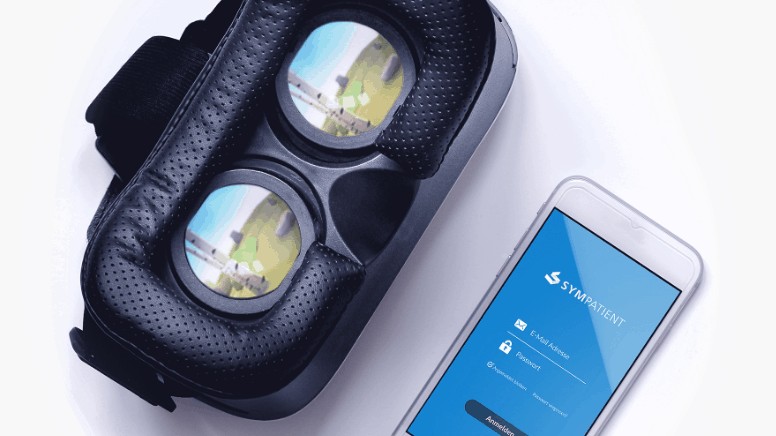In this article, Perfood CEO and founder Dominik Burziwoda shares some thoughts on risks and opportunities within the digital therapeutics space.

Founder and CEO, Perfood
Dominik is founder and CEO of Perfood, a Germany-based digital therapeutics startup and portfolio company of Verve Ventures. Perfood has developed proprietary technology for personalized low-glycemic diet as core mode of action of its digital therapeutics’ products. Prior to founding Perfood, Dominik was responsible for the operations of an international e-commerce startup after a career in investment banking and corporate finance. He graduated with a Master’s in Finance from IE Business School, a Master’s in Laws (LL.M.) from the University of Münster and a BSc in International Business Administration from Rotterdam School of Management, Erasmus University.
Softbank-backed Pear Therapeutics is going public in a SPAC transaction, valuing the company at 1.2 billion USD pre-money. The German Digital Healthcare Act has given rise to probably 50-100 digital therapeutics startups, out of which approx. 20 have received market access approval. Many of them seeking investment, many of them probably with substantially lower valuations than Pear.
Disclaimer: This is a founder’s perspective. A view from the inside. I don’t see numerous startups high level, but I do see some stuff first-hand and in-depth. I spoke with many venture capitalists (VCs) throughout the past years and received tons of questions. Whereas many questions have a point, some appear to me kind of weird and see problems where there are probably none. To me, great investing avoids not only type I errors but also type II errors, i.e. not betting on the wrong company but, perhaps more importantly, passing on a hit. Finally, as a founder, I put my whole energy into my company, but I am also an equity shareholder. So, we’re in the same boat here.
Regulatory risk
The German Digital Care Act became effective as of January 2020. By end of May 2020, manufacturers could file for market access approval. By October 2020, the first digital therapeutics were granted reimbursement-status, i.e. these products were covered by all German Statutory Health Insurance groups without any surcharge for patients. These insurance groups represent approx. 70 million German citizens.
Under German law, one should differentiate between CE-certification and reimbursement. CE-certification is the equivalent of FDA approval and means that products can be marketed to insurance groups and directly to patients. “Reimbursement” means, that the costs are actually covered by insurance groups.
To receive “reimbursement-status”, digital therapeutics must fulfill a set of requirements which the German Federal Institute of Drugs and Medical Devices published on its website. Main topics are data security, data protection, interoperability as well as pre-clinical and clinical data. Approval may be granted “on probation” or infinitely. Infinite approval requires strong clinical data from a controlled trial. Approval “on probation” requires strong pre-clinical real-world evidence and a concept for a randomized controlled clinical trial that must be completed within one year.
Moreover, Digital Therapeutics (DTx) manufacturers need to state plausibly, what the benefit of the product is. This sounds easy, but it is tough and can be subject to discussions.
Investors should consider:
- Is the product a digital therapy according to German law and if not, can it be changed to fit the regulation?
- How is a startup dealing with data security and data protection? It should be a serious focus and receive appropriate budgets.
- German DTx regulation is currently quite progressive. Having an internationalization strategy, however, is helpful to get rid of concentration risk.
Market and adoption risk – should you wait to see traction?
“Will physicians prescribe a digital therapy?” This question can also be reframed in “will patients use a specific digital therapy?” and “will physicians prescribe it?”. Whether patients will use a therapy is essentially a question of product. The digital therapies that Perfood, my company, is developing have a focus on personalized nutrition. We have seen strong traction of personalized nutrition solutions in the consumer space. Moreover, from expert interviews and market research we know that patients are aware of the benefits of a healthy diet and are looking for practical solutions. Whether physicians will prescribe a product will depend on whether they believe the product can help their patients. If there is strong pre-clinical or clinical data, great usability, and patient-centricity, they will probably be comfortable with prescribing a digital therapy. Particularly, as the most conservative therapy will likely be a digital therapy as they have virtually no adverse side-effects. Under German law, insurance groups may take physicians into recourse if they prescribe redundant medication. This recourse-risk does not exist for prescribing DTx. Hence, physicians have a personal incentive to prescribe DTx instead of drugs..
How much traction you can expect, surely will depend a bit on the indication that the DTx focuses on and the target group selection.
Oftentimes, VCs tell me they need to see traction before they invest. There is nothing wrong with this, of course. Just, I am sometimes not sure, whether the right VCs ask this question. Pear Therapeutics plans to make approx. 4 million USD in revenue in 2020. The also project strong growth with about 5x p.a. Yes, I admit, a 1.2 billion valuation is maybe aggressive when you solely look at these 4 million dollars in sales and 5x growth p.a. looks ambitious. But I think it’s possible and we do see similar traction for new drugs, after they receive marketing approval. German digital therapeutics companies are expectbeed to generate approx. 10,000 prescriptions in their first 12 months upon receiving reimbursement approval. They do so, with very limited marketing budgets. Given current price ranges, this will be 4 million Euros in sales on average per digital therapy product. The markets for many digital therapeutics’ products are huge with millions of people affected. If you are a Seed or Series A investor, there is a chance that a DTx startup can outgrow your investment scope quicker than you might think.
Investors should consider:
- To not worry too much about traction if they are early stage
- Rather look for preclinical data, product, prevalence of the target disease and target-group strategy.
Clinical risk
In case a German DTx is listed infinitely, clinical data will be available. This can be compared to pharmaceuticals and other DTx. In case a product is listed “on probation”, usually only pre-clinical real-world evidence will be available. In addition, third party data or a clear underlying pathological mechanism may exist. Such DTx manufacturers need to get clinical data within 12 months, which maybe quite ambitious depending on the scope of the study. We all know that clinical risk is real and even if proof-of-concept or pilot trials were done, the ultimate trial may yield different results all out of a sudden. This is a risk inherent to life sciences.
I often hear people saying, that “only controlled randomized clinical trials” (RTC) prove causality and anything else is useless. I completely disagree with that. Why? Because clinical trials are an artificial environment and do not reflect patients’ real life. Artificial environment gives artificial data. We don’t know this yet, but I hypothesize that real-world evidence gives us better insights on what a therapy actually does for most patients and for healthcare costs. If I were to negotiate a pay-for-performance contract, I probably would give more weight to my real-world evidence than to my RCT data. Real-world evidence can be gathered in various ways, using standardized tools, following guidelines of medical societies, retrospective, prospective and with control groups. It can be monitored and analyzed by independent researchers. There is a wide range of quality of real-world evidence available and today’s discussions on this topic are way too binary. My opinion is: real-world evidence can be a great way for de-risking, if a product doesn’t have controlled clinical data, yet. In a pay-for-performance world, it might even be better than controlled clinical data.
Other risks that are more hands-on are ethics approval, study center and patient recruitment. Has the manufacturer received ethics approval? This can take 6 months or longer, which is awful if you only have got 12 months to finalize the RCT. Does the study center have enough personnel to conduct patient visits? Sounds easy, but it’s not since you may only have 60-90 working days for patient inclusions. If the trial is smaller, this risk is mitigated, but reaching primary endpoints gets tougher. It’s a trade-off that must be well managed.
Investors should consider:
- What is the pathological mechanism of a DTx and how is the quality of real-world evidence?
- Did the study receive ethics approval, yet? How are the capacities at the study side? What is the patient recruitment strategy?
Repricing risk
German DTx are free to set their own price-points in year one upon receiving reimbursement approval. Are these prices random? Definitely not! Manufacturers will always consider market prices, cost, and reputation. No single price has been finally negotiated in German DTx, hence a market standard hasn’t emerged yet. Some rules that we are familiar with from pharmaceuticals, however, might also apply to digital therapies. First, insurance groups want to save money. Effective therapies decrease physician visits, hospitalizations and cost for other therapies. Therapies that are without side effects, lower the cost for overuse of medications and diseases caused by such side effects. Even though digital therapies cannot be compared to pharmaceuticals, substitution may happen in various cases and it may be worth to consider the costs of potential substitute drugs. Those are likely those who have a similar profile in terms of effectiveness and side effects.
Some DTx manufacturers have called for value-based reimbursement approaches. Such innovative approaches may take some time, but particularly in markets with less standardized and regulated price-discovery schemes, such as Germany’s private insurance groups or the USA, such approaches may be a promising strategy. Hence, it is worth to consider what economic outcomes may be expected in value-based care world.
Investors should consider:
-
- What are other therapies for the DTx’s target disease and what are the cost of these therapies?
- Looking at side-effects and effectiveness, how does the digital therapy compare to such therapy options?
- Are there opportunities for value-based compensation and how could they look like? Are the founders considering such approaches?
Product risk: content, UX, design – what’s the playbook?
Oftentimes, VCs ask me about engagement metrics and long-term patient-relationship. This type of thinking, I assume, comes from traditional consumer internet and SaaS companies. Even though continuous patient-relationships certainly have benefits, I don’t think that they make or break a business case. In pharmaceuticals, drugs are being prescribed as long as patients need them. Some diseases are chronic, and drugs are prescribed and taken forever. But some diseases are completely cured, and drug prescriptions come to an end. This, however, does not make it a bad business to treat these diseases. Why wouldn’t it be similar in digital therapeutics? In my view, engagement and product need to be assessed individually by each disease and its underlying progression dynamics.
For most diseases, very limited digital therapy options currently exist. Unlike consumers, patients cannot switch deliberately between various products according to their brand, design, UX or content preferences. This puts less pressure on digital therapeutics companies than on their consumer peers, when it comes to investing in product, content and brand. Yet, great design, content und UX can be expected to drive engagement and effectiveness of the therapy. DTx manufacturers need to balance investing in an “effective product” while not “overinvesting” in expensive, redundant content and features. “He who heals is right” is the likely mantra in digital therapeutics when it comes to product decisions. At Perfood, we first ask ourselves, how product decisions affect patient behavior that then affects the pathological mechanism of a disease.
Investors should consider:
-
- Product decisions in DTx should lead to improved effectiveness.
- The dynamic of a disease should be considered when judging product performance metrics
Written by
WITH US, YOU CANCO-INVEST IN DEEP TECH STARTUPS

Verve's investor network
With annual investments of EUR 60-70 mio, we belong to the top 10% most active startup investors in Europe. We therefore get you into competitive financing rounds alongside other world-class venture capital funds.
We empower you to build your individual portfolio.
More News
30.11.2020
Perfood (Personalized Diet): EUR 5 million Series A
The German digital therapeutic startup has received 5 million Euro in its Series A funding round. Boehringer Ingelheim Venture Fund led the round.
17.08.2020
“Our core business is the human metabolism”
Eating right is easier than people think, explains nutritional expert Prof. Christian Sina in this interview. But people need to know how different meals affect them, because the reaction is highly individual. Based on this premise, digital health startup MillionFriends was founded.
03.02.2020
A world premiere in digital health
On the 29th of January 2020, the biggest German health insurance announced the launch of a novel anxiety therapy: Invirto. This premiere is a major milestone for the digital therapeutics startup Sympatient which is developing Invirto. Sympatient’s co-founder and managing director Christian Angern explains how this all came about.
Startups,Innovation andVenture Capital
Sign up to receive our weekly newsletter and learn about investing in technologies that are changing the world.




